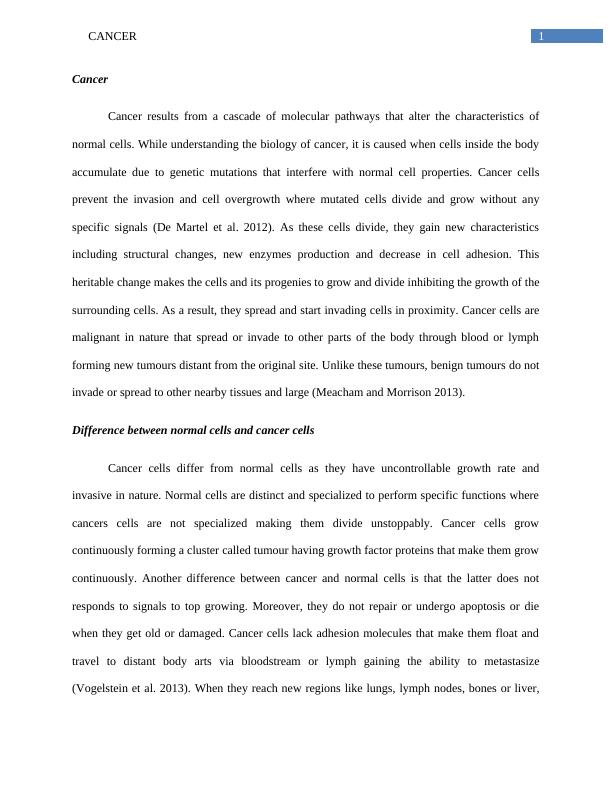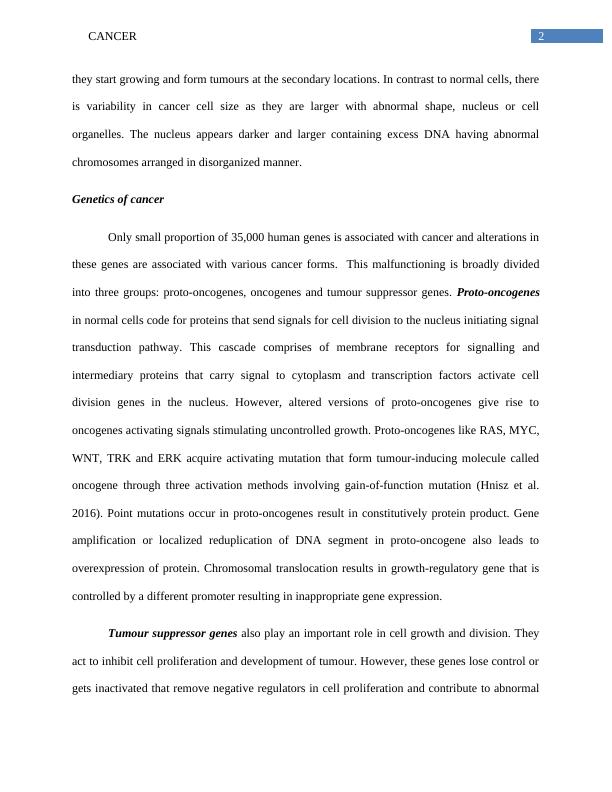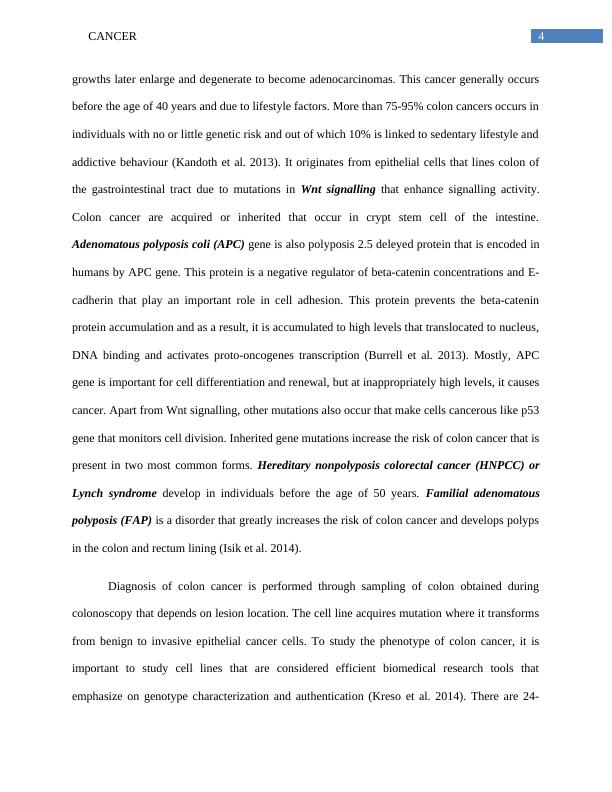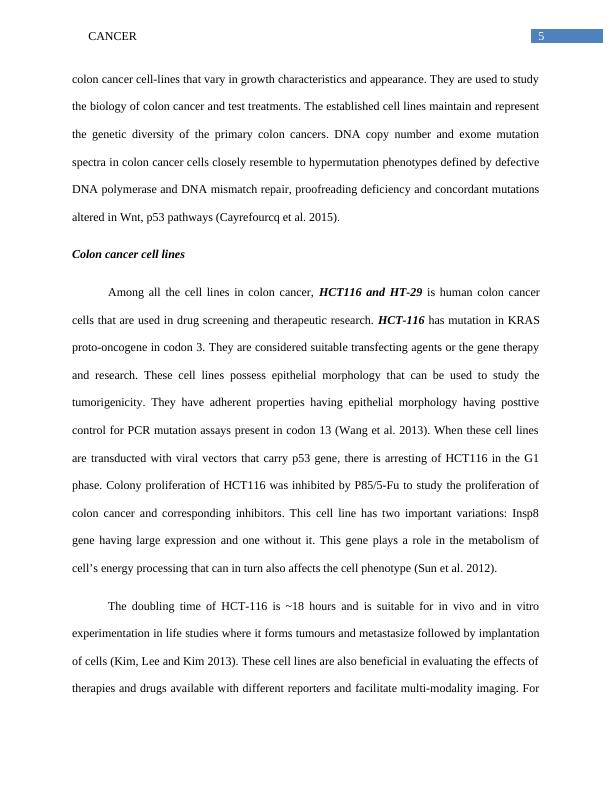Understanding Cancer: Biology, Genetics, Types and Colon Cancer Cell Lines
Anisomycin and its analogues induce cell death in breast cancer cells through a caspase-independent mechanism.
29 Pages8389 Words113 Views
Added on 2023-06-11
About This Document
This article provides an in-depth understanding of cancer, including its biology, genetics, types, and colon cancer cell lines. It discusses the differences between normal and cancer cells, genetics of cancer, types of cancer, and colon cancer. It also provides information on HCT116 and HT-29 colon cancer cell lines.
Understanding Cancer: Biology, Genetics, Types and Colon Cancer Cell Lines
Anisomycin and its analogues induce cell death in breast cancer cells through a caspase-independent mechanism.
Added on 2023-06-11
ShareRelated Documents
Running head: CANCER
Cancer
Name of the Student
Name of the University
Author note
Cancer
Name of the Student
Name of the University
Author note

1CANCER
Cancer
Cancer results from a cascade of molecular pathways that alter the characteristics of
normal cells. While understanding the biology of cancer, it is caused when cells inside the body
accumulate due to genetic mutations that interfere with normal cell properties. Cancer cells
prevent the invasion and cell overgrowth where mutated cells divide and grow without any
specific signals (De Martel et al. 2012). As these cells divide, they gain new characteristics
including structural changes, new enzymes production and decrease in cell adhesion. This
heritable change makes the cells and its progenies to grow and divide inhibiting the growth of the
surrounding cells. As a result, they spread and start invading cells in proximity. Cancer cells are
malignant in nature that spread or invade to other parts of the body through blood or lymph
forming new tumours distant from the original site. Unlike these tumours, benign tumours do not
invade or spread to other nearby tissues and large (Meacham and Morrison 2013).
Difference between normal cells and cancer cells
Cancer cells differ from normal cells as they have uncontrollable growth rate and
invasive in nature. Normal cells are distinct and specialized to perform specific functions where
cancers cells are not specialized making them divide unstoppably. Cancer cells grow
continuously forming a cluster called tumour having growth factor proteins that make them grow
continuously. Another difference between cancer and normal cells is that the latter does not
responds to signals to top growing. Moreover, they do not repair or undergo apoptosis or die
when they get old or damaged. Cancer cells lack adhesion molecules that make them float and
travel to distant body arts via bloodstream or lymph gaining the ability to metastasize
(Vogelstein et al. 2013). When they reach new regions like lungs, lymph nodes, bones or liver,
Cancer
Cancer results from a cascade of molecular pathways that alter the characteristics of
normal cells. While understanding the biology of cancer, it is caused when cells inside the body
accumulate due to genetic mutations that interfere with normal cell properties. Cancer cells
prevent the invasion and cell overgrowth where mutated cells divide and grow without any
specific signals (De Martel et al. 2012). As these cells divide, they gain new characteristics
including structural changes, new enzymes production and decrease in cell adhesion. This
heritable change makes the cells and its progenies to grow and divide inhibiting the growth of the
surrounding cells. As a result, they spread and start invading cells in proximity. Cancer cells are
malignant in nature that spread or invade to other parts of the body through blood or lymph
forming new tumours distant from the original site. Unlike these tumours, benign tumours do not
invade or spread to other nearby tissues and large (Meacham and Morrison 2013).
Difference between normal cells and cancer cells
Cancer cells differ from normal cells as they have uncontrollable growth rate and
invasive in nature. Normal cells are distinct and specialized to perform specific functions where
cancers cells are not specialized making them divide unstoppably. Cancer cells grow
continuously forming a cluster called tumour having growth factor proteins that make them grow
continuously. Another difference between cancer and normal cells is that the latter does not
responds to signals to top growing. Moreover, they do not repair or undergo apoptosis or die
when they get old or damaged. Cancer cells lack adhesion molecules that make them float and
travel to distant body arts via bloodstream or lymph gaining the ability to metastasize
(Vogelstein et al. 2013). When they reach new regions like lungs, lymph nodes, bones or liver,

2CANCER
they start growing and form tumours at the secondary locations. In contrast to normal cells, there
is variability in cancer cell size as they are larger with abnormal shape, nucleus or cell
organelles. The nucleus appears darker and larger containing excess DNA having abnormal
chromosomes arranged in disorganized manner.
Genetics of cancer
Only small proportion of 35,000 human genes is associated with cancer and alterations in
these genes are associated with various cancer forms. This malfunctioning is broadly divided
into three groups: proto-oncogenes, oncogenes and tumour suppressor genes. Proto-oncogenes
in normal cells code for proteins that send signals for cell division to the nucleus initiating signal
transduction pathway. This cascade comprises of membrane receptors for signalling and
intermediary proteins that carry signal to cytoplasm and transcription factors activate cell
division genes in the nucleus. However, altered versions of proto-oncogenes give rise to
oncogenes activating signals stimulating uncontrolled growth. Proto-oncogenes like RAS, MYC,
WNT, TRK and ERK acquire activating mutation that form tumour-inducing molecule called
oncogene through three activation methods involving gain-of-function mutation (Hnisz et al.
2016). Point mutations occur in proto-oncogenes result in constitutively protein product. Gene
amplification or localized reduplication of DNA segment in proto-oncogene also leads to
overexpression of protein. Chromosomal translocation results in growth-regulatory gene that is
controlled by a different promoter resulting in inappropriate gene expression.
Tumour suppressor genes also play an important role in cell growth and division. They
act to inhibit cell proliferation and development of tumour. However, these genes lose control or
gets inactivated that remove negative regulators in cell proliferation and contribute to abnormal
they start growing and form tumours at the secondary locations. In contrast to normal cells, there
is variability in cancer cell size as they are larger with abnormal shape, nucleus or cell
organelles. The nucleus appears darker and larger containing excess DNA having abnormal
chromosomes arranged in disorganized manner.
Genetics of cancer
Only small proportion of 35,000 human genes is associated with cancer and alterations in
these genes are associated with various cancer forms. This malfunctioning is broadly divided
into three groups: proto-oncogenes, oncogenes and tumour suppressor genes. Proto-oncogenes
in normal cells code for proteins that send signals for cell division to the nucleus initiating signal
transduction pathway. This cascade comprises of membrane receptors for signalling and
intermediary proteins that carry signal to cytoplasm and transcription factors activate cell
division genes in the nucleus. However, altered versions of proto-oncogenes give rise to
oncogenes activating signals stimulating uncontrolled growth. Proto-oncogenes like RAS, MYC,
WNT, TRK and ERK acquire activating mutation that form tumour-inducing molecule called
oncogene through three activation methods involving gain-of-function mutation (Hnisz et al.
2016). Point mutations occur in proto-oncogenes result in constitutively protein product. Gene
amplification or localized reduplication of DNA segment in proto-oncogene also leads to
overexpression of protein. Chromosomal translocation results in growth-regulatory gene that is
controlled by a different promoter resulting in inappropriate gene expression.
Tumour suppressor genes also play an important role in cell growth and division. They
act to inhibit cell proliferation and development of tumour. However, these genes lose control or
gets inactivated that remove negative regulators in cell proliferation and contribute to abnormal

3CANCER
tumour cell proliferation (Yates and Campbell 2012). Mutations occur in DNA repair genes like
mismatch repair (MMR) genes, nucleotide excision repair (NER) group, DNA crosslink repair
that results in inherited cancer syndromes. DNA repair mechanism is the backbone of survival;
however, decreased efficiency or inactivation occurs by epigenetic gene activation mechanism
that affects DNA repair activity of the genes (Jeggo, Pearl and Carr 2016).
Types of cancer
Carcinoma cancers begin in tissue or skin that covers the surface of glands or internal
organs forming solid tumours. Examples comprises of breast cancer, prostate cancer, colorectal
and lung cancer. Sarcoma begins in the connective tissue that connects and supports the body
developing in nerves, muscles, fat, joints, tendons, cartilage, blood vessels or bone. Leukaemias
are blood cancers that begin when there is change in structure and uncontrollable growth occurs
in blood cells. The four main types of leukaemia are acute and chronic lymphocytic leukaemia,
acute and chronic myeloid leukaemia. Lymphomas are cancer that begins in lymphatic system
causing Hodgkin and non-Hodgkin’s lymphoma. Melanomas are cancers that begin in cells that
form melanocytes that are specialized cells synthesizing melanin, pigment that impart colour to
the skin causing skin cancer (Sandoval and Esteller 2012). Colon cancer is also a type of
adenocarcinoma that is discussed in the subsequent section.
Colon cancer
Colon cancer is the large intestine cancer that makes up the final part of the digestive
tract. Mostly, colon cancer begins as a benign or non-cancerous clump of cells known as
adenomatous polyps. These polyps are small and show few symptoms. They comprise of excess
abnormal and normal appearing cells in the glands that cover colon’s inner wall. These abnormal
tumour cell proliferation (Yates and Campbell 2012). Mutations occur in DNA repair genes like
mismatch repair (MMR) genes, nucleotide excision repair (NER) group, DNA crosslink repair
that results in inherited cancer syndromes. DNA repair mechanism is the backbone of survival;
however, decreased efficiency or inactivation occurs by epigenetic gene activation mechanism
that affects DNA repair activity of the genes (Jeggo, Pearl and Carr 2016).
Types of cancer
Carcinoma cancers begin in tissue or skin that covers the surface of glands or internal
organs forming solid tumours. Examples comprises of breast cancer, prostate cancer, colorectal
and lung cancer. Sarcoma begins in the connective tissue that connects and supports the body
developing in nerves, muscles, fat, joints, tendons, cartilage, blood vessels or bone. Leukaemias
are blood cancers that begin when there is change in structure and uncontrollable growth occurs
in blood cells. The four main types of leukaemia are acute and chronic lymphocytic leukaemia,
acute and chronic myeloid leukaemia. Lymphomas are cancer that begins in lymphatic system
causing Hodgkin and non-Hodgkin’s lymphoma. Melanomas are cancers that begin in cells that
form melanocytes that are specialized cells synthesizing melanin, pigment that impart colour to
the skin causing skin cancer (Sandoval and Esteller 2012). Colon cancer is also a type of
adenocarcinoma that is discussed in the subsequent section.
Colon cancer
Colon cancer is the large intestine cancer that makes up the final part of the digestive
tract. Mostly, colon cancer begins as a benign or non-cancerous clump of cells known as
adenomatous polyps. These polyps are small and show few symptoms. They comprise of excess
abnormal and normal appearing cells in the glands that cover colon’s inner wall. These abnormal

4CANCER
growths later enlarge and degenerate to become adenocarcinomas. This cancer generally occurs
before the age of 40 years and due to lifestyle factors. More than 75-95% colon cancers occurs in
individuals with no or little genetic risk and out of which 10% is linked to sedentary lifestyle and
addictive behaviour (Kandoth et al. 2013). It originates from epithelial cells that lines colon of
the gastrointestinal tract due to mutations in Wnt signalling that enhance signalling activity.
Colon cancer are acquired or inherited that occur in crypt stem cell of the intestine.
Adenomatous polyposis coli (APC) gene is also polyposis 2.5 deleyed protein that is encoded in
humans by APC gene. This protein is a negative regulator of beta-catenin concentrations and E-
cadherin that play an important role in cell adhesion. This protein prevents the beta-catenin
protein accumulation and as a result, it is accumulated to high levels that translocated to nucleus,
DNA binding and activates proto-oncogenes transcription (Burrell et al. 2013). Mostly, APC
gene is important for cell differentiation and renewal, but at inappropriately high levels, it causes
cancer. Apart from Wnt signalling, other mutations also occur that make cells cancerous like p53
gene that monitors cell division. Inherited gene mutations increase the risk of colon cancer that is
present in two most common forms. Hereditary nonpolyposis colorectal cancer (HNPCC) or
Lynch syndrome develop in individuals before the age of 50 years. Familial adenomatous
polyposis (FAP) is a disorder that greatly increases the risk of colon cancer and develops polyps
in the colon and rectum lining (Isik et al. 2014).
Diagnosis of colon cancer is performed through sampling of colon obtained during
colonoscopy that depends on lesion location. The cell line acquires mutation where it transforms
from benign to invasive epithelial cancer cells. To study the phenotype of colon cancer, it is
important to study cell lines that are considered efficient biomedical research tools that
emphasize on genotype characterization and authentication (Kreso et al. 2014). There are 24-
growths later enlarge and degenerate to become adenocarcinomas. This cancer generally occurs
before the age of 40 years and due to lifestyle factors. More than 75-95% colon cancers occurs in
individuals with no or little genetic risk and out of which 10% is linked to sedentary lifestyle and
addictive behaviour (Kandoth et al. 2013). It originates from epithelial cells that lines colon of
the gastrointestinal tract due to mutations in Wnt signalling that enhance signalling activity.
Colon cancer are acquired or inherited that occur in crypt stem cell of the intestine.
Adenomatous polyposis coli (APC) gene is also polyposis 2.5 deleyed protein that is encoded in
humans by APC gene. This protein is a negative regulator of beta-catenin concentrations and E-
cadherin that play an important role in cell adhesion. This protein prevents the beta-catenin
protein accumulation and as a result, it is accumulated to high levels that translocated to nucleus,
DNA binding and activates proto-oncogenes transcription (Burrell et al. 2013). Mostly, APC
gene is important for cell differentiation and renewal, but at inappropriately high levels, it causes
cancer. Apart from Wnt signalling, other mutations also occur that make cells cancerous like p53
gene that monitors cell division. Inherited gene mutations increase the risk of colon cancer that is
present in two most common forms. Hereditary nonpolyposis colorectal cancer (HNPCC) or
Lynch syndrome develop in individuals before the age of 50 years. Familial adenomatous
polyposis (FAP) is a disorder that greatly increases the risk of colon cancer and develops polyps
in the colon and rectum lining (Isik et al. 2014).
Diagnosis of colon cancer is performed through sampling of colon obtained during
colonoscopy that depends on lesion location. The cell line acquires mutation where it transforms
from benign to invasive epithelial cancer cells. To study the phenotype of colon cancer, it is
important to study cell lines that are considered efficient biomedical research tools that
emphasize on genotype characterization and authentication (Kreso et al. 2014). There are 24-

5CANCER
colon cancer cell-lines that vary in growth characteristics and appearance. They are used to study
the biology of colon cancer and test treatments. The established cell lines maintain and represent
the genetic diversity of the primary colon cancers. DNA copy number and exome mutation
spectra in colon cancer cells closely resemble to hypermutation phenotypes defined by defective
DNA polymerase and DNA mismatch repair, proofreading deficiency and concordant mutations
altered in Wnt, p53 pathways (Cayrefourcq et al. 2015).
Colon cancer cell lines
Among all the cell lines in colon cancer, HCT116 and HT-29 is human colon cancer
cells that are used in drug screening and therapeutic research. HCT-116 has mutation in KRAS
proto-oncogene in codon 3. They are considered suitable transfecting agents or the gene therapy
and research. These cell lines possess epithelial morphology that can be used to study the
tumorigenicity. They have adherent properties having epithelial morphology having posttive
control for PCR mutation assays present in codon 13 (Wang et al. 2013). When these cell lines
are transducted with viral vectors that carry p53 gene, there is arresting of HCT116 in the G1
phase. Colony proliferation of HCT116 was inhibited by P85/5-Fu to study the proliferation of
colon cancer and corresponding inhibitors. This cell line has two important variations: Insp8
gene having large expression and one without it. This gene plays a role in the metabolism of
cell’s energy processing that can in turn also affects the cell phenotype (Sun et al. 2012).
The doubling time of HCT-116 is ~18 hours and is suitable for in vivo and in vitro
experimentation in life studies where it forms tumours and metastasize followed by implantation
of cells (Kim, Lee and Kim 2013). These cell lines are also beneficial in evaluating the effects of
therapies and drugs available with different reporters and facilitate multi-modality imaging. For
colon cancer cell-lines that vary in growth characteristics and appearance. They are used to study
the biology of colon cancer and test treatments. The established cell lines maintain and represent
the genetic diversity of the primary colon cancers. DNA copy number and exome mutation
spectra in colon cancer cells closely resemble to hypermutation phenotypes defined by defective
DNA polymerase and DNA mismatch repair, proofreading deficiency and concordant mutations
altered in Wnt, p53 pathways (Cayrefourcq et al. 2015).
Colon cancer cell lines
Among all the cell lines in colon cancer, HCT116 and HT-29 is human colon cancer
cells that are used in drug screening and therapeutic research. HCT-116 has mutation in KRAS
proto-oncogene in codon 3. They are considered suitable transfecting agents or the gene therapy
and research. These cell lines possess epithelial morphology that can be used to study the
tumorigenicity. They have adherent properties having epithelial morphology having posttive
control for PCR mutation assays present in codon 13 (Wang et al. 2013). When these cell lines
are transducted with viral vectors that carry p53 gene, there is arresting of HCT116 in the G1
phase. Colony proliferation of HCT116 was inhibited by P85/5-Fu to study the proliferation of
colon cancer and corresponding inhibitors. This cell line has two important variations: Insp8
gene having large expression and one without it. This gene plays a role in the metabolism of
cell’s energy processing that can in turn also affects the cell phenotype (Sun et al. 2012).
The doubling time of HCT-116 is ~18 hours and is suitable for in vivo and in vitro
experimentation in life studies where it forms tumours and metastasize followed by implantation
of cells (Kim, Lee and Kim 2013). These cell lines are also beneficial in evaluating the effects of
therapies and drugs available with different reporters and facilitate multi-modality imaging. For

End of preview
Want to access all the pages? Upload your documents or become a member.
Related Documents
Breast Cancer Assignment 2022lg...
|7
|1676
|15
Pathogenesis of Breast Cancer and Lymphoedemalg...
|6
|1702
|170
Hallmarks of cancerlg...
|14
|3792
|453
Case Study - Colorectal Cancer: Nursing Process and Holistic Carelg...
|12
|3804
|337
Understanding Drug Therapy for Non-Small Cell Lung Cancerlg...
|15
|4854
|35
HER-2 Positive Breast Cancerlg...
|16
|4060
|499
